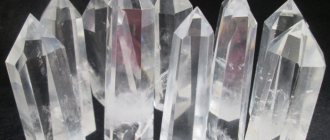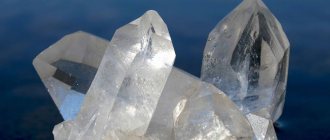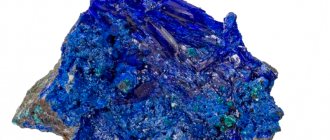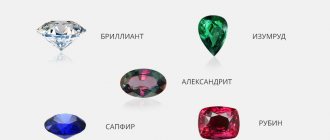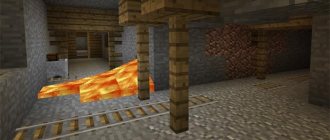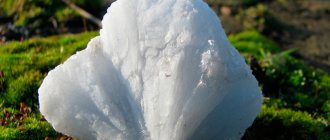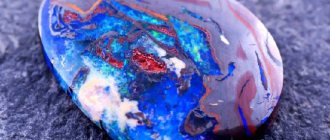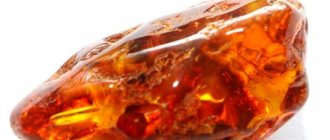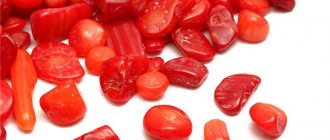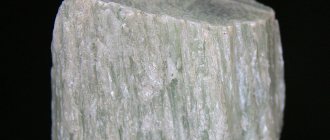| Category | Oxides (minerals) |
| Title in English | Quartz |
| Formula | SiO2 |
| Group | Group of glass-forming oxides |
| Color | White, Colorless, Yellow, Red, Green, Brown, Pink, Orange, Grey, Purple, Black |
| Stroke color | White |
| Shine | Glass, Bold, Matte |
| Transparency | Transparent |
| singonia | Trigonal |
| Hardness | 7 |
| Cleavage | Imperfect |
| Density, g/cm³ | 2,6 — 2,65 |
| Kink | Conchoidal |
| origin of name | The word quartz came to us from the German language, however, there are two versions of its translation. According to the first, to create termani “quartz” they used the word “quarz”, which translates as solid. According to the second option, they used “querklüfterz,” which literally translates as “ore of sparkling veins.” |
Quartz, a polymorph of silicon dioxide, is one of the most common minerals on our planet; it serves as a rock-forming mineral for many rocks of igneous and metamorphic origin. The earth's crust contains about 12% pure quartz and more than 60% in other stones.
Physico-chemical characteristics of quartz
Pure quartz is colorless or white when it contains cracks and other defects.
Its chemical composition is silicon dioxide. Quartz crystals that are colorless and free from defects are known as rock crystal and are used as a gemstone in their own right. Due to admixtures of other elements, such as iron oxides, quartz is colored in different shades. For example, morion is black, amethyst is purple, and citrine has a yellow tint.
— Advertising —
Quartz is characterized by polymorphism. Under normal conditions, α-quartz, also known as the low-temperature modification, is stable. By β-quartz we mean its high-temperature subtype. Independent polymorphic modifications of quartz include cristobalites, tridymites, coesites, and stishovites.
Quartz crystals are oblong hexagons that look like a sharpened pencil. Often form drusen. Large brushes are formed from small crystals.
Quartz has a trigonal system and conchoidal fracture. Hardness on the Mohs scale 7. Specific gravity 2.6 g/cm3. The mineral is soluble in alkalis and hydrofluoric acid. Its melting point is from 1713 to 1728 °C. It has dielectric and piezoelectric properties.
Morphological characteristics
A typical crystalline form in terms of morphology for quartz is a hexagonal prism, having at one or both ends, depending on the type, a triangular or hexagonal head in the shape of a pyramid. Often the crystal structure becomes thinner towards the head. The faces of the prism have transverse strokes. Often the crystals have the shape of an elongated prism, in which a pair of rhomboids and a hexagonal prism have developed faces that form the crystal head.
Dipyramidal crystals of pseudohexagonal shape are much less common. Often quartz crystals of regular shape have a complex double structure with the formation of twin sections in accordance with the so-called Dauphine and Brazilian laws
This occurs not only during crystal growth, but also as a result of internal transformations at the stage of beta-alpha polymorphic transitions when the temperature environment changes. Such processes are accompanied by compression and some mechanical deformations.
Metamorphic and igneous quartz ores are formed in the form of grains of irregular, isometric shapes, which usually grow together with grain-like samples of other mineral rocks. Often quartz crystals encrust tonsils and voids inside effusive materials.
If we consider sedimentary rocks, quartz is found in their composition in the form of geodes (secretions/discharges), veinlets, concretions, as well as brushes of short-prismatic small crystals inside limestone voids. You can often find quartz of sedimentary origin in the form of fragments of sand and pebbles.
Types of Quartz
- Aventurines are colored yellow or brownish-red.
- Agates are distinguished by a layered-banded structure.
- Amethysts are endowed with an exquisite purple color.
- Binghemites are iridescent quartz with an admixture of goethites.
- Hairworms are a type of rock crystal that contains fine-needle crystals of rutiles and tourmalines.
- Rock crystal is colorless and transparent quartz.
- Flint is a fine-grained cryptocrystalline aggregate of silica with a variable composition, which includes quartz, chalcedony, cristobalite, and occasionally opal.
- Morions are black quartz.
- Overflows are opaque stones that are a mixture of quartz and chalcedony.
- Prazemes contain actinolite, which is why they are colored green.
- Prasiolites are onion-green minerals obtained by calcination of yellow quartz.
- Rauchtopazes (smoky quartz) – painted in gray or brown light tones.
- Rose quartz.
- Chalcedony is a cryptocrystalline fine-fiber stone. Translucent or translucent, painted white or honey yellow
- Citrines are lemon-yellow gems.
- Sapphire quartz is colored blue and has a coarse-grained structure.
- Cat's eye is a stone of white, pinkish or gray color with iridescence and unusual light reflection.
- Hawkeye - quartz intergrowths with bluish-gray amphibole.
- Tiger's eye is golden brown in color.
- Onyxes are brown minerals with patterns of white and black, also found in shades of red-brown, brown-yellow, honey, white with yellow or pink layers.
- Heliotropes are opaque dark green stones with red stripes or spots, which consist of fine-grained quartz, chalcedony, and iron compounds.
Compatibility
Many types of quartz are highly compatible with human energy. The crystalline structure of a natural mineral has a beneficial effect on the psyche, provided that the stone is selected taking into account individual characteristics. It is better to purchase jewelry and items made from minerals where you can first hold them in your hands and inspect them thoroughly.
With other stones
Quartz crystals usually have many inclusions and impurities of other minerals. In rocks, its grains grow together with other minerals. Jewelry made from semi-precious varieties combines well with other semi-precious minerals. Less valuable varieties of quartz are used as beautiful inlays in jewelry with semi-precious and precious stones.
With zodiac signs
Quartz is well suited for Taurus; representatives of this sign should especially pay attention to agate and rose quartz. Capricorns will appreciate snow-white quartz. Fiery Aries and Sagittarius will prefer stones of red shades. Golden citrine is suitable for Leos. Aquarius, Cancer and Pisces are unlikely to remain indifferent to transparent rock crystals. Sapphire quartz is also suitable for Pisces. Libra will find harmony with amethyst and rose quartz. Scorpios might like black morion and smoky quartz.
The mineral is distinguished by great diversity and good energy, so it is well suited for some signs and neutral for others. There is no negative influence for any signs.
With names
Almost all names are compatible with quartz. Separately, we can highlight female names: Alina, Faina, Milena. Men's - Kirill, Luka.
Magical properties of quartz
Quartz attracts love, luck, success and financial well-being to its owner, helps to develop imagination and think actively, creatively.
Of all quartz, the most magically valuable is rock crystal. This stone has a high energy potential and can be programmed to help achieve any goals. Milk quartz is used for meditation, in order to free thoughts and go deeper within oneself. Smoky quartz is suitable for business people and becomes an excellent assistant in making important decisions. Amethysts and chrysoprase give peace. Carnelian is a symbol of fidelity.
All quartz have a calming effect, relieve fears and help cope with stress. They are also good at clearing rooms of negative energy.
Price
The cost of quartz depends on its type:
- The cost of a hairball starts from 350, ending with 36,000 rubles.
- For rock crystal, be prepared to pay from 100 to 34,000 rubles.
- The price of smoky crystal is from 100 to 24,000 rubles.
- Morion can cost from 1220 to 3800 rubles.
- Amethyst costs from 2,400 to 42,000 rubles.
- Citrine can be purchased for 1140 – 7600 rubles.
Important! The final cost of jewelry depends on the type of stone, its weight, purity, and degree of transparency.
Healing properties of quartz
Quartz has a good effect on the respiratory system.
Quartz crystals can alleviate colds. Traditional medicine widely uses quartz water, which is made by infusing water with quartz or passing ordinary water through a special quartz filter. It is believed that such water is endowed with many beneficial properties, is useful in the prevention of various diseases, stimulates and rejuvenates the body. It is also used in cosmetology. Washing with quartz water gives the skin elasticity, smoothness and firmness, smooths out wrinkles, and eliminates acne. In addition, lotions and compresses with quartz water are used to treat bruises, burns, cuts, and inflammatory processes on the skin.
Interesting Facts
Students become familiar with basic information about minerals already in primary school. The teacher can share the following interesting information about quartz in class:
- A mineral can react differently to temperature fluctuations. Thus, black quartz heated to +300 degrees acquires a golden color, and up to +400 it becomes transparent.
- Many people know the expression “quartz watch”. To control the accuracy of movement, they use crystals of this mineral. Watches with quartz crystals are considered the most accurate.
- Quartz lenses are much stronger than glass lenses.
These interesting facts are quite understandable for 2nd grade children. Using such information in the lesson will help to enliven perception and will contribute to better assimilation of the material.
Industries using quartz
Quartz has found application in the design of optical instruments, ultrasound generators, telephone and radio equipment, electronic devices, and refractory materials.
It is simply irreplaceable in the production of glass and ceramics. As a glass-forming oxide, it is the primary glass produced from pure silica, rock crystal, vein quartz and quartz sand. Varieties of quartz with beautiful structure, shape and unusual coloring are very popular in jewelry.
Artificial quartz
Today, artificial quartz is produced using the hydrothermal method. It is widely used for industrial purposes as it is homogeneous and chemically pure. In this case, single crystals are always grown whose piezo-optical properties are better expressed than those of natural minerals.
When it comes to jewelry, synthetic methods make it possible to create quartz in a variety of colors. For example, very rare green quartz or a pure blue variety that does not exist at all in nature. The production of synthetic quartz is widespread in Russia.
Main deposits and production
The mineral crystallizes from magma. It is one of the main components of granite pegmatites. The internal fragments of pegmatite veins are often pure quartz and form a quartz core. Crystal-bearing quartz veins directly arise in the earth's crust at high pressure with the participation of hot springs (hydrothermal processes).
Quartz is common in sedimentary rocks (limestones, dolomites). It is the main component of sandstones. It is often found in cavities filled with sandy-clayey material, where it is mined using an excavator method.
Industrial mining of quartz in Russia began after the first samples were found in the Urals in the 19th century.
In Russia, the largest deposit of this valuable mineral is located in the Urals, in the Chelyabinsk region (Kyshtym deposit). Quartz is mined in Buryatia, Komi, Karelia, Yakutia, Transbaikalia, and Crimea.
Quartz deposits are also found in countries such as Australia, Chile, India, Norway, Austria, USA, Brazil, etc. The mineral is distributed almost everywhere.
How to distinguish real quartz from a fake
Quartz counterfeits are rare, as this mineral is quite common. Imitations are usually made for its rare varieties. Thus, fake rose quartz is created by coloring smoky quartz with iron and manganese. Such dyes cannot penetrate deeply and produce an uneven color, which also oxidizes easily and loses its visual appeal.
